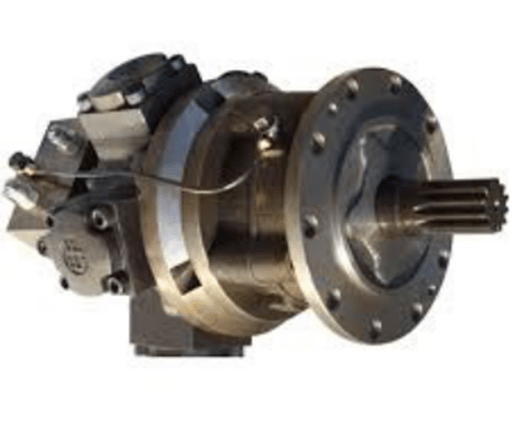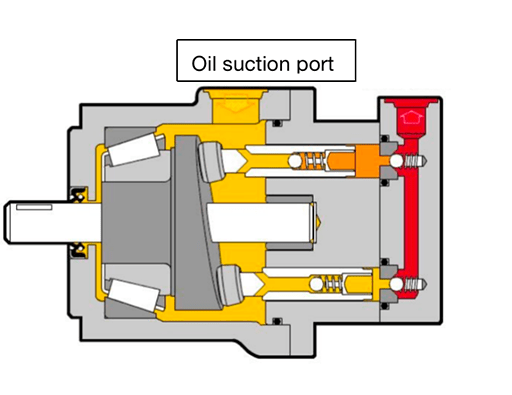
Figure 1: Hydraulic motor.
Hydraulic motor is a conversion element that converts the pressure energy of liquid into rotary motion machinery. Hydraulic motor can play a similar role to motor. The difference is that in the hydraulic system, it generates torque by inputting pressure oil to realize continuous rotary motion and drive the working mechanism to do work. Therefore, the hydraulic motor belongs to the hydraulic actuator in the hydraulic system.
1. Selection Method of Hydraulic Motor
1. The main basis for selecting the hydraulic motor is the requirements of the host machine for the hydraulic system, such as torque, speed, working pressure, displacement, shape and connection size, volumetric efficiency, total efficiency, quality, price, source of goods, convenience of use and maintenance, etc.
2. There are many kinds of hydraulic motors with different characteristics, so the appropriate hydraulic motor should be selected according to the specific purpose and working condition. Low-speed motor can be selected for low-speed operation. High-speed motor acceleration and deceleration device also can be used. The choice of the two schemes should be based on the structure and space conditions, equipment cost, whether the driving torque is reasonable, etc.

Figure 2: Low-speed motor (left) and high-speed motors (right).
3. After determining the type of motor used, several specifications that can meet the needs can be selected from the hydraulic motor product series according to the required speed and torque. And then a comprehensive analysis can be carried out. First, the corresponding pressure drop, flow and efficiency can be found (or calculated) by using the characteristic curves of various specifications; Then, the technical and economic evaluation is used to determine the specific specifications. If the original cost is the most important element, the motor that meets the torque requirements and the one wich makes the system flow smaller and the pressure lower should be selected, so that the specifications of hydraulic source, control valve and pipeline can be small. If the operation cost is the most important element, the motor with high overall efficiency should be selected; If the service life is the most important element, the motor with the lowest pressure drop should be selected, and the final product selected is mostly a compromise of the above scheme.

Figure 3: Select the most suitable motor as required.
2. Precautions when Using Hydraulic Motor
1.The hydraulic motor is usually allowed to work under the pressure that exceeds the rated pressure by 20% - 50% in a short time, but the instantaneous maximum pressure cannot appear at the same time as the maximum speed.
2.There is a certain limit on the back pressure of the oil return circuit of the hydraulic motor. When the back pressure is large, a leaking oil pipe must be set.
3.Generally, the maximum torque and maximum speed of the hydraulic motor should not appear at the same time. The actual speed should not be lower than the minimum speed of the motor to avoid crawling. When the speed required by the system is low, and the performance parameters of the motor such as speed and torque are not easy to meet the working requirements. A reduction mechanism can be added between the motor and its driven host. In order to operate smoothly at extremely low speed, the leakage of the motor must be constant and there must be a certain return oil back pressure.
4.In order to prevent the brake motor working as a pump from cavitation or loss of braking capacity, it should be ensured that there is sufficient oil makeup pressure at the oil suction port of the motor at this time, which can be realized through the oil makeup pump in the closed circuit or the back pressure valve; When the hydraulic motor drives a large inertia load, a bypass check valve in parallel with the motor should be set in the hydraulic system to make up oil, so as to avoid oil shortage of the inertia motor during shutdown.

Figure 4: Oil suction port of the motor.
5.For hydraulic motors that cannot bear additional axial and radial forces, or hydraulic motors that can bear additional axial and radial forces. But the actual axial and radial forces of the load are greater than the allowable axial or radial forces of the hydraulic motor, elastic couplings should be considered to connect the output shaft and the working mechanism. For motors that need low-speed operation, check their minimum stable speed.
6.It is necessary to lock the motor for a long time to prevent load movement. Spring loaded hydraulic pressure should be used on the motor shaft to release the mechanical brake.
7. The hydraulic motor should not be disassembled casually after failure during operation.
Related Info
Hydraulic Motor TypesWhat is Hydraulic Motor
Troubleshooting of Hydraulic Motor
How to install a Vane Pump


